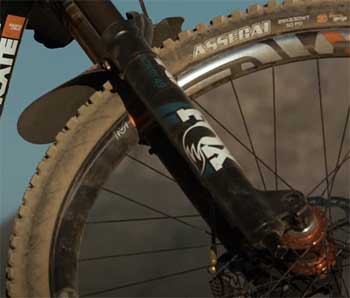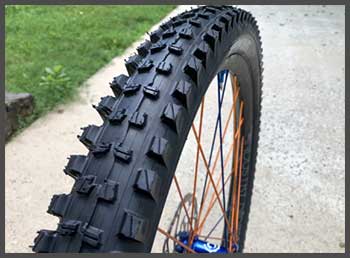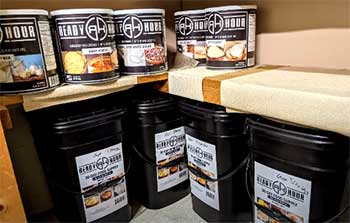In the realm of mountain biking, a sport defined by thrill and precision, tires form the essential connective tissue between riders and the diverse terrains they conquer.
Today, we’ll be diving into the specifics of two popular mountain bike tires: the Assegai and the DHF from Maxxis. We’ll analyze their strengths, weaknesses, and everything in-between.
A Brief Comparison Table
| Feature | Assegai | DHF |
| Designed By | Greg Minnaar | Maxxis |
| Tread Design | Aggressive with large, widespread lugs | Versatile with ramped and channel-cut knobs |
| Rolling Resistance | Higher due to aggressive tread | Lower due to ramped knobs |
| Weight | Generally heavier | Lighter |
| Versatility | Excels in soft, loose or muddy conditions | Performs well in a wide array of conditions |
| Mud Shedding | Excellent due to open lug pattern | Good, but may struggle with heavy mud due to tighter lug spacing |
| Casing Options | EXO, EXO+, DoubleDown, and Downhill | EXO, EXO+, DoubleDown, and Downhill |
| Compound Options | Dual, 3C MaxxTerra, 3C MaxxGrip | Dual, 3C MaxxTerra, 3C MaxxGrip |
| Best For | Aggressive riders prioritizing grip and control | Riders seeking a balance of speed, durability, and control |
Setting the Stage: Assegai And DHF Tires

Both the Assegai and the DHF are products of Maxxis, a titan in the tire industry known for the quality and performance of its products.
The Assegai, named after the powerful Zulu spear, was designed by downhill racing legend Greg Minnaar.
Its aim?
To create a tire that offers incredible grip and performance under diverse conditions.
On the other hand, we have the DHF (Downhill Front), a stalwart in the Maxxis line up and a favorite among riders for its versatility and reliability. This tire, with its design focussed on steering precision and braking performance, has been a fixture on many podiums worldwide.
- Advantages of Assegai Tires
The Assegai has several standout features that make it a formidable choice. Its large, aggressive lugs provide superior traction on a variety of terrains, wet or dry.
The Assegai offers excellent control and grip, particularly in turns, and its wide spacing between lugs ensures that it sheds mud effectively.
Furthermore, it’s available in different compounds, including Maxxis’ triple compound (3C MaxxTerra and 3C MaxxGrip), allowing you to tailor your ride to specific trail conditions.
It also features the robust DoubleDown (DD) and Downhill (DH) casings, known for resisting punctures and offering durability.
- Assegai Tires: Areas to Consider
Despite its robust attributes, the Assegai does have a few points worth considering. Its aggressive tread design and larger lugs mean it has more rolling resistance, potentially slowing you down on hard-packed or fast-rolling terrains.
It’s also a bit heavier than some other models, which could make a difference on those long, uphill grinds.
Also Read: Differences Between Maxxis Dissector And DHR2 Tires.
The DHF Tire: A Proven Performer

The DHF tire is lauded for its versatility.
Its tread design offers a superb combination of grip, control, and speed across varied terrains, and it excels particularly well in hardpack and loose-over-hard conditions.
The DHF’s reputation for durability is backed by several options in casing and rubber compounds, including the 3C MaxxTerra and 3C MaxxGrip, providing a balance of traction and tread wear.
The DHF’s ‘ramped’ lug design also helps to reduce rolling resistance.
- Considering the DHF
While the DHF is a tried and true favorite, it’s not without its areas of consideration. Its performance in muddy conditions is less than optimal due to its tighter lug spacing, which can lead to mud build-up.
Key Differences Between Assegai and DHF Tires
While both the Assegai and DHF are top-of-the-line Maxxis creations, understanding their key differences is crucial in making an informed choice.
- Tread Design
One of the most prominent differences between the Assegai and DHF lies in their tread design.
The Assegai tire sports a highly aggressive pattern, with large and widespread lugs that bite into the terrain. This pattern ensures superior traction, particularly in soft, loose, or muddy conditions.
The open lug pattern, in turn, provides better mud-shedding capability, making the Assegai a formidable ally in wet and muddy terrains.
The DHF, on the other hand, features a versatile tread design, optimized for a wide array of conditions. The tread comprises a mix of ramped knobs for low rolling resistance and channel-cut knobs for better edge grip and control.
This design, combined with the tire’s larger volume, offers a superb balance of speed, grip, and control.
- Rolling Resistance
The Assegai, with its aggressive, widespread lugs, tends to have more rolling resistance compared to the DHF. This means that while the Assegai provides more grip, it can feel slower, especially on hard-packed or fast-rolling terrains.
In contrast, the DHF, with its ramped and strategically placed knobs, offers lower rolling resistance. This makes the DHF faster and easier to pedal on hard-packed trails.
- Weight
The Assegai, due to its design and robust construction, tends to be heavier than the DHF. This increased weight can impact the bike’s handling and overall responsiveness, particularly on uphill climbs or when accelerating.
The DHF, being lighter, can contribute to a more nimble and responsive bike, which could be advantageous in races or rides involving a lot of climbing or quick maneuvering.
- Versatility
While both tires are highly versatile, the DHF is often regarded as the more adaptable of the two. Its tread design and reduced rolling resistance make it a go-to choice for riders traversing a broad range of conditions, from dry, hard-packed trails to loose gravel and rocks.
The Assegai, although versatile in its own right, truly shines in specific conditions, particularly in soft, loose, or muddy trails where its aggressive tread pattern can fully engage.
When choosing between the Assegai and DHF, it essentially boils down to the specific requirements of your ride.
For aggressive riders who prioritize grip and control, especially in soft or muddy conditions, the Assegai is an excellent choice. However, it might feel slower on hard-packed trails due to its design.
In contrast, the DHF offers a balance of speed, durability, and control, performing well on a wide array of terrains, except for very muddy conditions where the Assegai would shine.
Also Read: Comparison of Assegai And Magic Mary Tires.
Frequently Asked Questions (FAQ)
The answer depends on your needs. The Assegai excels in grip and control but may feel slower on hard-packed surfaces. The DHF is a versatile choice for various terrains, except muddy conditions.
The Assegai can be used both as a front and rear tire, but it shines particularly when used upfront due to its superior grip.
Yes, you can use the Assegai as a rear tire, although it may increase rolling resistance due to its aggressive tread pattern.
In terms of rolling speed, the DHF is generally faster than the DHR (Downhill Rear). The DHR’s design is more focused on braking and cornering traction, which may decrease rolling speed compared to the DHF.
Final Thoughts
In conclusion, the Assegai and DHF tires are both formidable choices. Picking between the two often comes down to understanding your riding style, the terrains you plan to tackle, and what characteristics you prioritize in a tire.
Happy riding!


